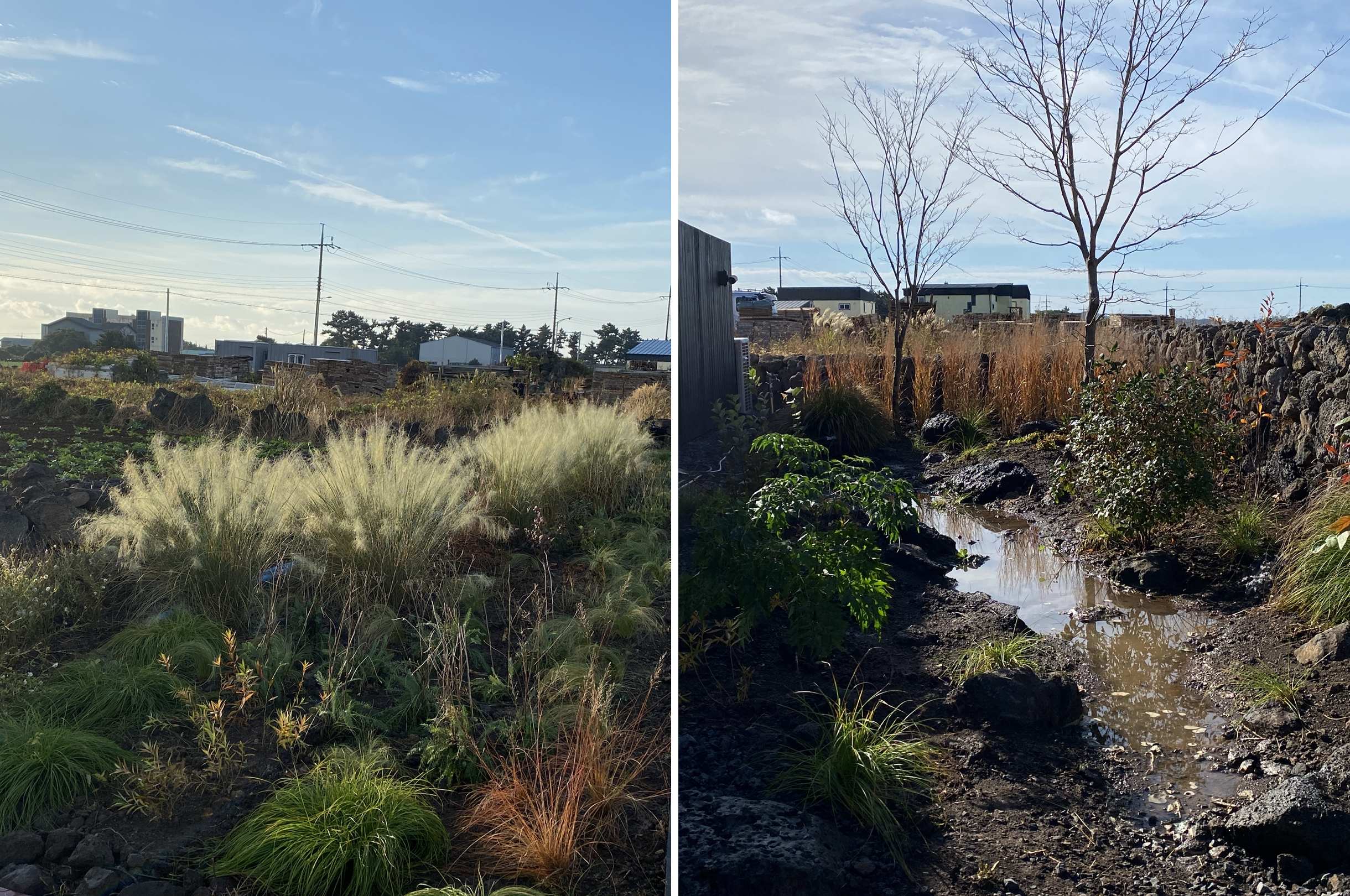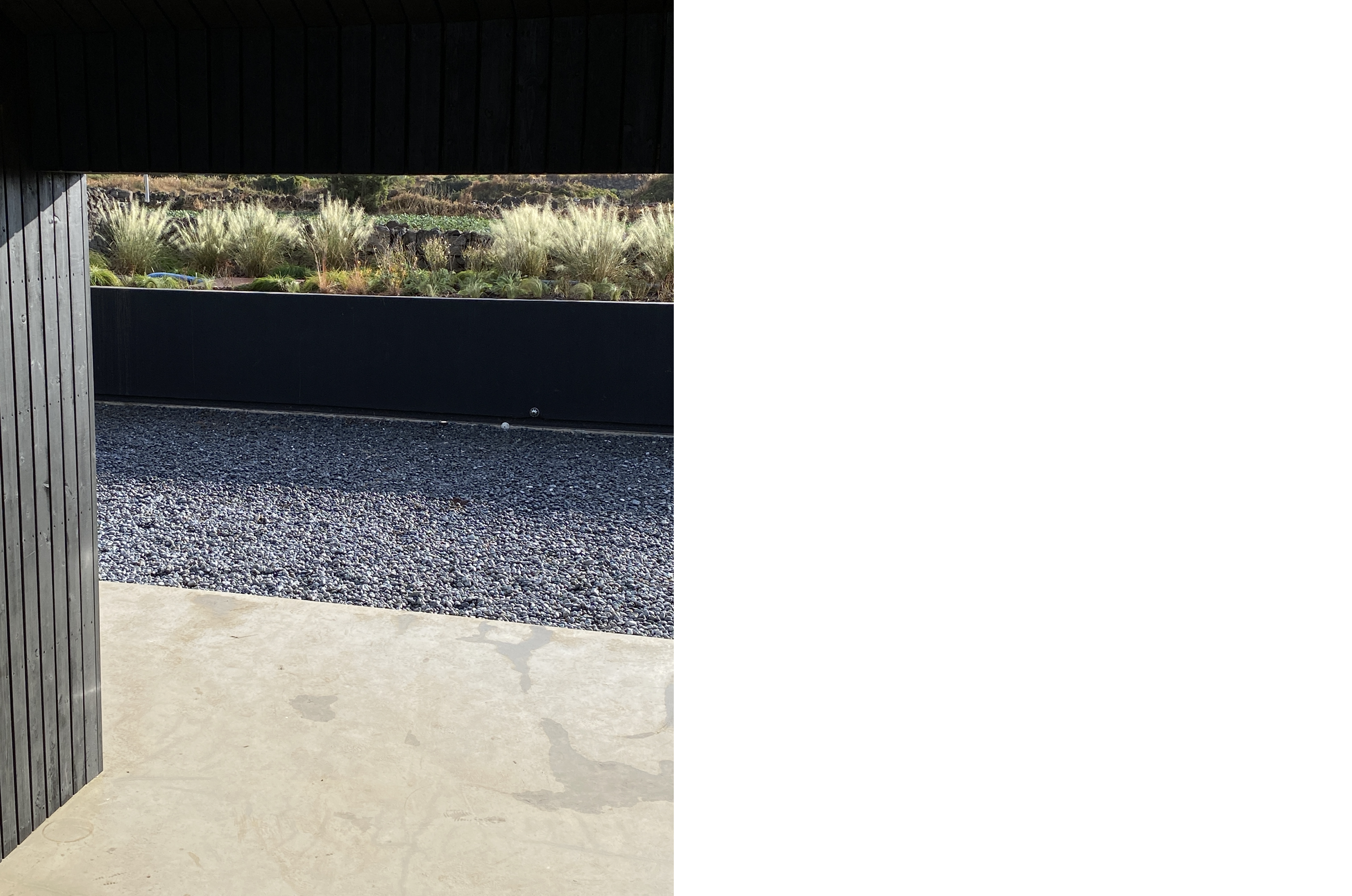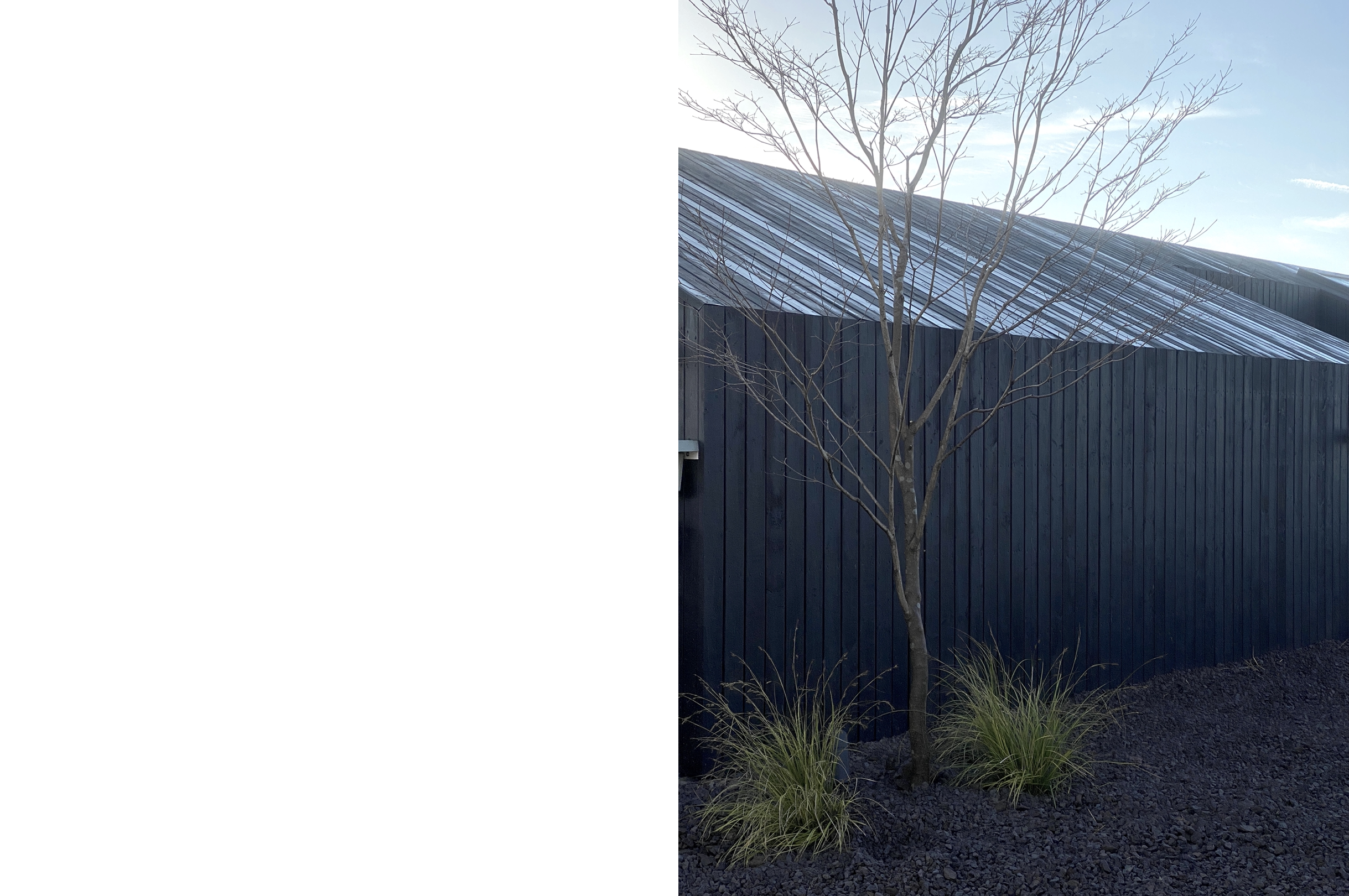Sagyeri House (2023-)
with SANHA



note
산방산이 아름다워 건축주는 이 땅을 선택했다고 합니다. 산방산을 향해서는 통창이 온전하게 열려있었으며, 집의 구성과 같이 엮어져 있던 미러폰드는 이따금씩 새들이 들러 목을 축이곤 했으며, 어느 시간대에는 하늘을 담기도 합니다. 산방산을 가리지 않으며 수평선으로부터 오는 안정감과 너른함은 계속 이어가도록 하는게 중요한 방향이었습니다. 두 종류의 그라스로 수평선을 받칩니다. 그 종류는 Muhlenbergia capilaris ‘White Cloud’와 Miscanthus sinensis ‘Autumn Antem’입니다. 채도가 높고 화려한 색을 싫어하신다는 건축주의 선호에 맞춰 톤을 잡습니다. 봄과 여름동안 배경역할을 하다가 가을부터는 꽃 피우는 두 식물이 오히려 주인공 역할을 합니다. 그와 더불어 톤앤매너가 맞고 생육환경이 동일한 초원의 식물들을 심습니다. 폭이 좁고 넓지 않은 면적을 복잡하게 만들기보다는 스케일에 맞춰서 식물을 군집화하는 방향을 택합니다. 종류가 많지 않은 조건에서는 꽃에 집중하기보다는 좀 더 오랜 시간 볼 수 있는 형태와 질감에 중점을 둡니다. 반복적인 배치로 균형을 만듭니다.
집은 원 지반의 높이보다 반층 정도 내려가서 얹혀졌습니다. 그 덕에 집을 들어가는 과정에서 느낄 수 있는 입체감이 특별하고, 집 안에서는 둘러 쌓여진 아늑함이 인상깊습니다. 다만 제주도라는 지역적 특성상 강수량이 많은 탓에 설비의 예상치를 넘어서는 침수가 있곤 했습니다. 배수가 잘 되는 제주도 흙의 특성상 빗물정원은 물의 체류시간이 짧아서 약점이 될 수 있는데, 이 집의 경우 오히려 문제를 해결할 수 있는 이점이 되어 흙을 파서 물그릇으로서의 빗물정원을 형성합니다. 대지의 조형 또한 기능적일때 가장 자연스럽고 아름다운 형상이 될지도 모르겠습니다.
빗물정원은 부엌의 전경이 되어주는 터이자 입구로 들어오기 전에 마주하는 첫 풍경이 될 정원입니다. 고려하려고 했던 주요 시점은 세 방향입니다. 집의 전경과 함께 읽히는 전체적인 시야, 집으로 들어서기 전 긴 축으로 읽히는 정원의 시야, 마지막으로 부엌 안에서 가장 가깝게 정원이 느껴질 시야. 첫번째 시점을 위해서 주차장 옆까지 수목을 배치해야 한다고 생각한 부분이 핵심적이었습니다. 기본적으로는 남은 두 시점을 모두 만족시키려고 노력했지만 하나가 아쉬운 선택이 드는 때에는 둘 중 부엌에서 보는 풍경이 좀 더 많은 시간이 될 것 같아 부엌의 시야를 우선시합니다. 집 옆 초원의 풍경을 연결시키되 과하지 않도록 왜성품종인 Panicum virgatum ‘Apache Rose’를 식재합니다. 웅덩이 주변으로는 해당 미기후에 적합한 식물들을 심습니다.
It is said that the builder chose this site because of Sanbang-San’s beauty. The windows facing the mountains were completely open, and the mirror ponds that were woven into the fabric of the house would occasionally be visited by birds to quench their thirst, and at certain times of the day they would capture the sky. It was important to me to continue the sense of stability and spaciousness that comes from the horizon, which is supported by two types of grasses: Muhlenbergia capilaris 'White Cloud' and Miscanthus sinensis 'Autumn Antem'. These two plants play a background role during the spring and summer and then become the main characters as they bloom in the fall. In addition, we plant meadow plants with the same tone and manners and the same growing environment. In environments that don't allow for a wide variety of plants, I focus less on flowers and more on forms and textures that can be seen for longer periods of time. I try to create balance with a less diverse but more repetitive arrangement.
The house was raised about half a floor below the height of the original ground, giving it a special three-dimensional feeling when entering the house, and a cozy feeling when inside. However, due to the high amount of precipitation in Jeju Island, there was often flooding that exceeded the expectations of the facility. Due to the well-drained nature of Jeju Island soil, rain gardens can be a weakness due to the short retention time of water, but in the case of this house, it became an advantage to solve the problem, digging into the soil to form a rain garden as a water bowl. Perhaps the most natural and beautiful form of landscape is when it is also functional, and the rain garden is the foreground of the kitchen and the first thing you see before entering the house.
The main viewpoints we tried to consider were from three directions. The overall view, which is read in conjunction with the foreground of the house, the view of the garden as a long axis before entering the house, and finally the view of the garden closest to the kitchen. For the first view, it was key that the trees were placed all the way to the side of the parking lot. Basically, I tried to satisfy the other two viewpoints, but when it came down to a choice between one or the other, I prioritized the view from the kitchen because I knew I would be spending more time there. Plant a dwarf variety of Panicum virgatum ’Apache Rose‘ to tie in the landscape of the meadow next to the house, but not overwhelm it. Around the pool, plant plants that are appropriate for that microclimate.